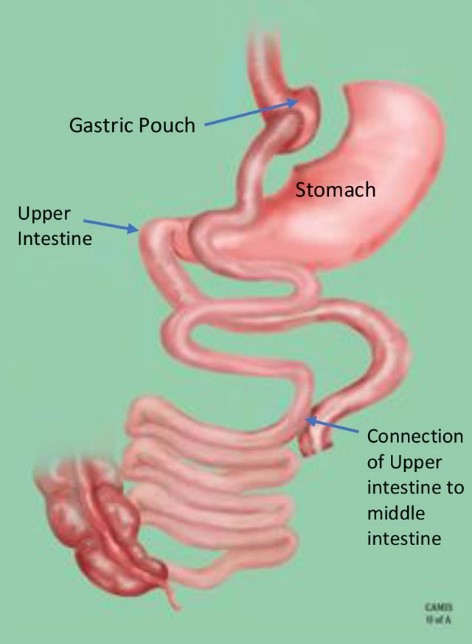How is a gastric bypass done?

How bariatric surgery works—a gastric pouch and new connections of the small intestine
Image credit: Centre for Advancement of Surgical Education and Simulations (CASES)
To do a gastric bypass, the surgeon makes a small pouch, called a gastric pouch, in the upper part of the stomach. The pouch is about the size of an egg or golf ball.
The surgeon also separates the upper part of the small intestine from the middle part of the small intestine. The middle part of the small intestine is then attached to the gastric pouch. This directs food into the middle part of the small intestine, instead of the lower part of the stomach.
The upper part of the small intestine is then reattached to the middle part of the small intestine. This allows digestive juices from the stomach, pancreas, and gallbladder to mix with food to help it digest.
How does a gastric bypass help you lose weight?
The stomach pouch is small. You’ll only be able to eat a small amount of food at a time. The pouch holds about a ½ cup to 1 cup (125 to 250 mL) of food. This makes you feel full much sooner than you did when your stomach was full size.
The smaller opening in the gastric pouch also slows down the movement of food and drinks out of the pouch. This can help you to feel full for longer.
When you eat less food, you may take in fewer calories. Taking in fewer calories helps you lose weight.
You may gain weight back if you take in extra calories by:
- often choosing higher-calorie foods
- eating too much or eating small amounts of food too often (called grazing)
- often choosing very soft or liquid food and drinks that go through the gastric pouch easily
What are the risks or side effects of a gastric bypass?
The following are some of the risks and side effects of having a gastric bypass.
Feeling too full or sick after eating
If you eat more than the pouch can hold, you’ll feel uncomfortable. You may even feel sick to your stomach and throw up.
Dumping syndrome
If you have food and drinks that are higher in sugar, you may develop dumping syndrome. This is a group of symptoms that happen when food moves too fast from the stomach to the small intestine. Go to
After your surgery: Symptoms to watch for to learn more about dumping syndrome.
Not getting enough vitamins and minerals
Your body will absorb fewer nutrients from the food you eat. This happens because food doesn’t go into the lower part of the stomach and the upper part of the intestine.
You’re also at risk for low levels of many vitamins and minerals since you’re eating less and your body can’t absorb as many nutrients.
To help your body get enough vitamins and minerals after surgery:
- eat healthy meals and snacks
- take vitamin and mineral supplements each day
It’s important to go for regular blood tests to check your vitamin and mineral levels. This will help your healthcare team know how many extra vitamins and minerals your body needs.
